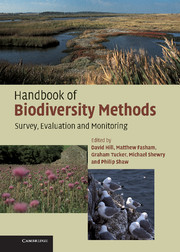Book contents
- Frontmatter
- Contents
- Preface
- Acknowledgements
- Part I Planning
- Part II Habitats
- 4 Introduction to habitat evaluation
- 5 Habitat requirements and issues
- 6 Methods for surveying habitats
- 7 Surveying and monitoring management or environmental impacts
- 8 Habitat conservation evaluation criteria
- Part III Species
- Appendix 1 Monitoring and reporting obligations under international conservation agreements
- Appendix 2 Relationship between BAP Priority Habitat and Broad Habitat categories and Habitats Directive nomenclature
- Appendix 3 Annotated list of key references for plant identification
- Appendix 4 Determining appropriate quadrat size for vegetation sampling
- Appendix 5 The relocation of permanent plots
- Appendix 6 Equipment required for undertaking different types of survey
- Recommended sources of further information
- References
- Glossary
- Index
7 - Surveying and monitoring management or environmental impacts
Published online by Cambridge University Press: 01 September 2010
- Frontmatter
- Contents
- Preface
- Acknowledgements
- Part I Planning
- Part II Habitats
- 4 Introduction to habitat evaluation
- 5 Habitat requirements and issues
- 6 Methods for surveying habitats
- 7 Surveying and monitoring management or environmental impacts
- 8 Habitat conservation evaluation criteria
- Part III Species
- Appendix 1 Monitoring and reporting obligations under international conservation agreements
- Appendix 2 Relationship between BAP Priority Habitat and Broad Habitat categories and Habitats Directive nomenclature
- Appendix 3 Annotated list of key references for plant identification
- Appendix 4 Determining appropriate quadrat size for vegetation sampling
- Appendix 5 The relocation of permanent plots
- Appendix 6 Equipment required for undertaking different types of survey
- Recommended sources of further information
- References
- Glossary
- Index
Summary
As well as surveying and monitoring the condition of features of interest on a site, it is also often necessary to monitor the effects of management practices or environmental impacts. Management is usually carried out with the aim of achieving a particular target condition for a feature; for example, grazing might be introduced to maintain the species richness of a grassland, or burning might be carried out to rejuvenate a patch of moorland. It therefore follows that the impacts of management need to be monitored to ensure that management practices are having the desired effect. If management appears to be ineffective or has adverse effects, then the management regime can be appropriately adjusted. Records of past management practices and changes resulting from these are therefore vital if interventionist site management is to be more than a hit or miss affair. Building up a body of knowledge on the effects of different levels of grazing, burning, etc. on different habitats will enable management regimes to be sensitively designed. Monitoring non-management impacts such as those caused by erosion or unplanned fires is also important. Erosion is a naturally occurring process in some habitats, but may also be caused or exacerbated by management practices. Surveying and monitoring the effects of, for example, developments such as ports, marinas, airports, built development and associated infrastructure is now the norm, and yet few such studies exist to show the effects of such environmental impacts.
- Type
- Chapter
- Information
- Handbook of Biodiversity MethodsSurvey, Evaluation and Monitoring, pp. 237 - 244Publisher: Cambridge University PressPrint publication year: 2005



